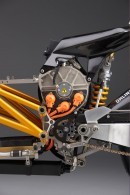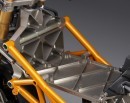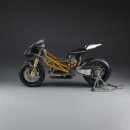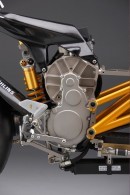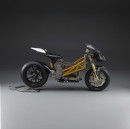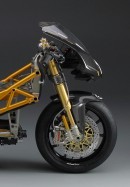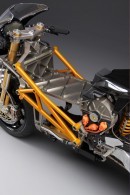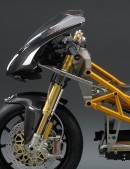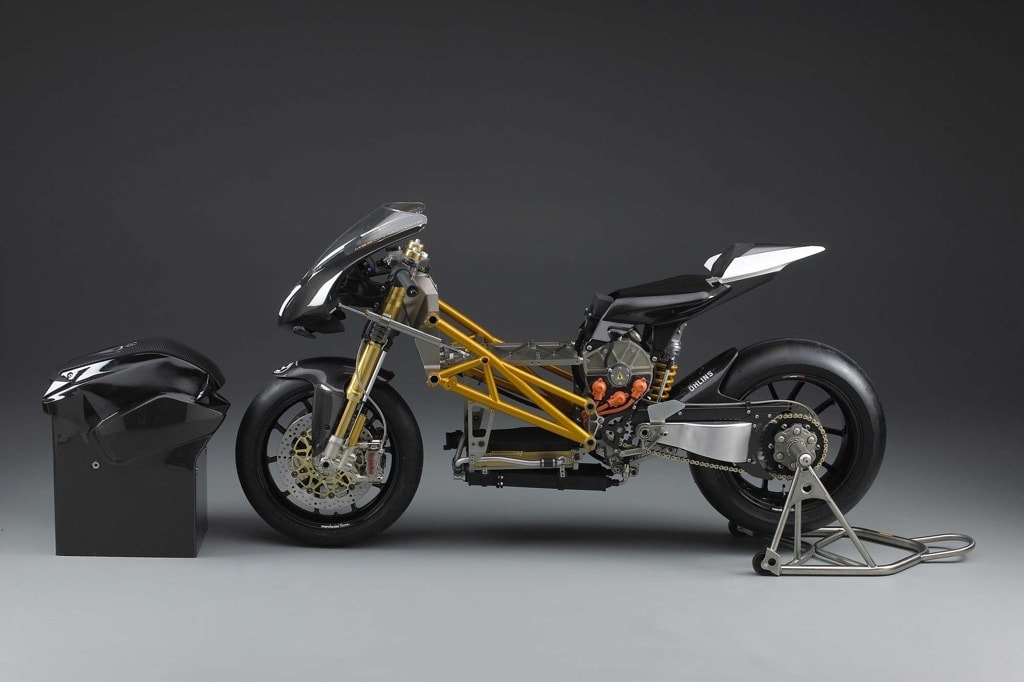Mission Motors have taken the wraps off their latest electric super-bike-like racing motorcycle, the Mission R, in mid-December 2010, revealing an exciting design that is aimed at proving that “green” bikes can be as much of a turn on as their gasoline-powered two-wheeled siblings.
Now, for a deeper view into the future of electric bike technology, we are going to take a sneak peak under Mission R’s carbon-laid skirt or better say, strip it until there are nothing but the bike’s chrome-moly trellis frame (designed by James Parker), engine and wheels left.
Carbon enclosed two-tiered battery pack make most of the bikes weight, with it’s mass centralized around the 141HP 3-phase AC induction motor.
Furthermore, Parker has been kind enough to guide us through the design process off this electric superbike via Asphalt and Rubber.
He started by explaining that any motorcycle chassis design combines three basic design elements: components (motor, frame, suspension, wheels, brakes, bars, footpegs, and more), geometries (Rake, trail, wheelbase, wheel travel, center of gravity, and more), and packages (lean-angle, ergonomic, aerodynamic, assembly and servicing).
“The Mission R chassis uses unique components to achieve the geometry and packaging demands of a high-performance motorcycle. The battery is a large box surrounded on four sides by three different structure types. At the front, a machined aluminum box serves as the steering head/fork mount and spans the full width of the battery. At the rear, the fully stressed “power unit” contains the motor, primary drive, and countershaft as well as the pivot for the swing arm,” Parker explains.
“On each side of the battery, connecting the steering head box and the power unit, are chrome-moly steel trellis sections. The battery is thus surrounded by protective structure to insure maximum safety. An aluminum plate that is integral to the battery serves as a further chassis element, providing longitudinal and lateral bracing to the 4-sided structure,” he continues.
“The single-sided swingarm, machined from billet aluminum, has a unique linear telescoping, rather than eccentric (as on other single-sided designs) chain adjustment, which allows adjustment without altering ride height,” Parker concludes.
Now, for a deeper view into the future of electric bike technology, we are going to take a sneak peak under Mission R’s carbon-laid skirt or better say, strip it until there are nothing but the bike’s chrome-moly trellis frame (designed by James Parker), engine and wheels left.
Carbon enclosed two-tiered battery pack make most of the bikes weight, with it’s mass centralized around the 141HP 3-phase AC induction motor.
Furthermore, Parker has been kind enough to guide us through the design process off this electric superbike via Asphalt and Rubber.
He started by explaining that any motorcycle chassis design combines three basic design elements: components (motor, frame, suspension, wheels, brakes, bars, footpegs, and more), geometries (Rake, trail, wheelbase, wheel travel, center of gravity, and more), and packages (lean-angle, ergonomic, aerodynamic, assembly and servicing).
“The Mission R chassis uses unique components to achieve the geometry and packaging demands of a high-performance motorcycle. The battery is a large box surrounded on four sides by three different structure types. At the front, a machined aluminum box serves as the steering head/fork mount and spans the full width of the battery. At the rear, the fully stressed “power unit” contains the motor, primary drive, and countershaft as well as the pivot for the swing arm,” Parker explains.
“On each side of the battery, connecting the steering head box and the power unit, are chrome-moly steel trellis sections. The battery is thus surrounded by protective structure to insure maximum safety. An aluminum plate that is integral to the battery serves as a further chassis element, providing longitudinal and lateral bracing to the 4-sided structure,” he continues.
“The single-sided swingarm, machined from billet aluminum, has a unique linear telescoping, rather than eccentric (as on other single-sided designs) chain adjustment, which allows adjustment without altering ride height,” Parker concludes.
